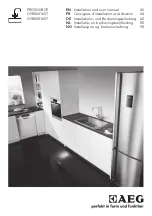
2
x
Safety
FA ROTEX A1 BOe - 02/2014
5
2.5 Instructions for operating safety
2.5.1 Before working on the heating system
Ɣ
Work on the heating system (such as installation, connection
and initial start-up) may only be carried out by authorised,
trained heating technicians.
Ɣ
Switch off the main switch and secure it against unintended
switching on when carrying out any work on the heating
system.
Ɣ
Seals must not be damaged or removed.
Ɣ
Make sure that the safety valves comply with the require-
ments of EN 12828 when connecting on the heating side, and
with the requirements of EN 12897 when connecting on the
domestic water side.
2.5.2 Electrical installation
Ɣ
Electrical installations must only be conducted by electrical
engineers and in compliance with valid electrical guidelines
as well as the specifications of the energy supply company.
Ɣ
Before completing the mains connection, compare the mains
voltage, indicated on the type plate (230 V, 50 Hz) with the
supply voltage.
Ɣ
Before beginning work on live parts, disconnect them from the
power supply (switch off main switch, remove fuse) and
secure against unintentional restart.
Ɣ
Equipment covers and service panels must be replaced as
soon as the work is completed.
2.5.3 Installation room
Ɣ
Operate ROTEX A1 BO only if sufficient combustion air
supply is ensured. If you operate the ROTEX A1 BO in a
room-air independent manner with a concentric air/flue gas
system (LAS) dimensioned as per ROTEX standard, this is
fulfilled automatically and there are no other conditions for the
equipment erection room. With installation in residential
rooms, this method of operation applies exclusively.
Ɣ
Make sure that, with installation in a room-air dependent or
limited room-air independent manner, an inlet air opening to
the outside of at least 150 cm
2
is provided.
Ɣ
Do not operate the ROTEX A1 BO by the ambient air
dependent method in rooms with aggressive vapours (e.g.
hair spray, perchloroethylene, carbon tetrachloride), strong
dust formation (e.g. workshop) or high humidity (e.g. laundry).
Ɣ
Strictly keep the minimum distances to walls and other
objects (see chapter 4.1).
2.5.4 Requirements for the heating water
Avoid damage caused by deposits and corrosion:
Observe
the relevant regulations of technology to prevent creation of cor-
rosion products and deposits.
Measures for desalination, softening or hardness stabilization are
necessary, if the filling and top-up water have a high total
hardness (>3 mmol/l - sum of the calcium and magnesium con-
centrations, calculated as calcium carbonate.
Using filling water and top-up water which does not meet the
stated quality requirements can cause a considerably reduced
service life of the equipment. The responsibility for this is entirely
that of the operator.
2.5.5 Heating system and sanitary connection
Ɣ
Create a heating system according to the safety requirements
of EN 12828.
Ɣ
With sanitary connection, you must observe;
– EN 1717 - Protection of domestic water from contamina-
tion in domestic water installations and general require-
ments concerning safety equipment for the prevention of
domestic water contamination by back-flow
– EN 806 - Technical regulations for domestic water instal-
lations (TRWI)
– and, in addition, the country-specific legal regulations.
During operation of the ROTEX A1 BO, the storage tank temper-
ature may exceed 60 °C, particularly when solar power is used.
Ɣ
Therefore, incorporate scald protection during the installation
of the system (domestic hot water mixing construcion, e.g.
VTA32,
15 60 16
).
2.5.6 Fuel
Ɣ
Use only the approved heating oils as fuel (see chapter 12
"Technical data").
2.5.7 Operation
Ɣ
Operate ROTEX A1 BO only with closed silencer hoods.
Ɣ
Only operate the ROTEX A1 BO if all the prerequisites as per
the checklist in chapter 5.2 are fulfilled.
2.5.8 Instructing the user/owner
Ɣ
Before you hand over the heating system, explain to the
owner how he/she can operate and check the heating
system.
Ɣ
Hand over the technical documentation (at least the operating
instruction manual and operating handbook) to the user and
advise him that these documents must be made available at
all times and be stored in the immediate vicinity of the unit.
Ɣ
Make a record of the handover by filling out and signing the
installation and instruction forms jointly with the user/owner.






































